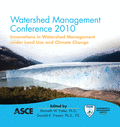Integrated Modeling of Green Infrastructure Components in an Area Served by Combined Sewers
Publication: Watershed Management 2010: Innovations in Watershed Management under Land Use and Climate Change
Abstract
The EPA's Kansas City, MO demonstration project on the use of green infrastructure to minimize combined sewer overflows will use a variety of integrated practices and modeling approaches. This extensive project will collect data before, during, and after implementation of a variety of control practices in a 100 acre pilot subwatershed, and in a parallel control subwatershed. The reduction of discharges to the drainage system during wet weather will be calculated using models and verified through field monitoring. The continuous models will determine the decreased amount of stormwater discharged for each event as the storage and infiltration facilities dynamically fill and drain over an extended period of time. WinSLAMM, the Source Loading and Management Model, conducts a continuous water mass balance for every storm in the study period. As an example, for rain barrels, water tanks or cisterns, capturing roof runoff, the model fills the available storage during rains. Between rains, the storage tank is drained according to the water demands for each month. If the tank is almost full from a preceding close rain (and not enough time was available to drain the storage tank), excess water from the event would be discharged to the drainage system after the tank fills. Curb-cut rain gardens/biofilters along a street are basically a cascading swale system where the site runoff is allowed to infiltrate. If the runoff volume is greater than the capacity of the rain gardens, the excessive water is discharged into the combined sewers. When evaluated together, the cisterns treat the roof runoff first, but the excess water is discharged to the curb-cut rain gardens for infiltration. The continuous simulation drains the devices between events, depending on the interevent conditions. As an example, if 200 ft2 rain gardens were used for each house in the 100 acre pilot subwatershed, up to about 90% of the annual roof runoff from directly connected roofs may be infiltrated. The use of a single 35 gallon rain barrel per house is expected to provide about a 24% reduction in directly connected roof runoff through irrigation to match ET. However, more than 25 rain barrels per house would be needed to reduce the roof's contributions by 90%. The use of rain gardens having a total area of 80ft2 and two 35 gallon rain barrels per house can collectively reduce the runoff from directly connected roofs by about 90%. Modeling during the project will involve a wide range of potential controls, well beyond the few examples noted here.
Get full access to this article
View all available purchase options and get full access to this chapter.
Information & Authors
Information
Published In
Copyright
© 2010 American Society of Civil Engineers.
History
Published online: Apr 26, 2012
ASCE Technical Topics:
- Climates
- Combined sewers
- Engineering fundamentals
- Environmental engineering
- Equipment and machinery
- Hydrologic engineering
- Infrastructure
- Lifeline systems
- Meteorology
- Precipitation
- Rainfall
- Rainfall-runoff relationships
- Roofs
- Sewers
- Storage tanks
- Stormwater management
- Structural engineering
- Structural systems
- Tanks (by type)
- Water and water resources
- Water discharge
- Water management
- Water storage
- Water supply
- Water supply systems
- Water tanks
- Water treatment
Authors
Metrics & Citations
Metrics
Citations
Download citation
If you have the appropriate software installed, you can download article citation data to the citation manager of your choice. Simply select your manager software from the list below and click Download.
